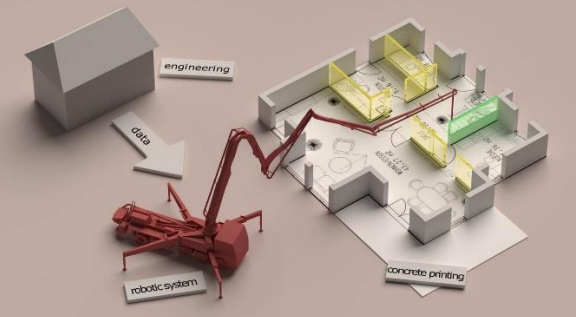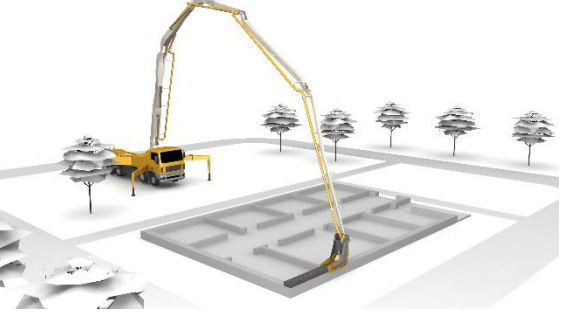Researchers from the Technische Universität Dresden have been exploring challenges within the construction industry. In their recently published paper, ‘Large-scale digital concrete construction – CONPrint3D concept for on-site, monolithic 3D printing,’ M. Krausea , J. Ottoa , A. Bulgakovb, and D. Sayfeddinec discuss additive manufacturing processes and their potential within the confines of today’s architecture and design.
 In exploring how 3D printing and AM processes could positively impact the construction industry, the researchers consider the following:
In exploring how 3D printing and AM processes could positively impact the construction industry, the researchers consider the following:
- Mechanical engineering
- Concrete technology
- Data management
- Construction management
As advances occur, TU Dresden continues to rely on CONPrint3D® (Concrete ON-site 3D-Printing). This system offers:
- Established machine technology
- Production of fully filled concrete structures
- Sustainable concrete formulations with a maximum grain size of up to 16 mm
- Use directly on construction site
For this study, the researchers investigated greater optimization of concrete printing using the CONPrint3D®. Because the consensus is in, and the majority of experts within construction agree that 3D printing offers greater efficiency, affordability, and design potential the researchers give their attention to this more progressive form of technology; in fact, CONPrint3D® can show savings up to 25 percent and processes may be up to six times faster—in comparison to typical masonry.
“Compared to the stationary industry, the boundary conditions are completely different for computer-aided manufacturing in the construction industry. Changing environmental conditions (such as site location, subsoil characteristics or environmental impacts) makes it difficult to introduce automated production methods on site. The increasing digitization and establishment of new planning methods, such as Building Information Modelling (BIM), can ease the introduction of automated processes on construction sites,” state the authors.
“The optimization of the printing strategies is extremely relevant to ensure the efficiency of the process. The construction process is usually computer simulated before printing.”
Researchers at TU Dresden have been searching for ways to better construction processes since 2014. Development of CONPrint3D® has been promising because printing occurs on-demand at the construction site (in-situ concrete construction), it represents a construction machine ‘established on the market,’ and large, fully filled concrete structures are created.
Path planning occurs, with consideration for the trajectory, constraints, speed, acceleration points, and more:
“When solving the problem of planning the trajectories of motion, sections of acceleration and braking of the printhead are provided. Planning of the trajectory is carried out in space and time, which ensures the passage of the printhead the nodal points of the working space at a given time period. The solution of the planning task is determined by the appointment of the robot, its kinematic characteristics, performed by the technological operation and the technical environment conditions.”
During the study, the researchers created new and adaptive 3D printing strategies for developing a new and continuous process chain, although neither their work in digital data preparation nor processing is ready yet.
“The aim of the international research project is to complete the digital process chain from BIM to machine-specific optimized G-Codes. At the Technical University of Dresden, research will continue to be carried out in order to achieve the goal of construction site application,” concluded the researchers.
Additive manufacturing has already offered an enormous boon to the construction industry overall, and especially with the versatility available in materials. And while this is a realm that is still evolving, construction 3D printers are being developed on a massive scale, and even for far-out tasks like construction in space. What do you think of this news?
Let us know your thoughts! Join the discussion of this and other 3D printing topics at 3DPrintBoard.com.

left: Approach of CONPrint3D® right: Extrusion of smaller concrete strands with round corners and subsequent concrete filling
Subscribe to Our Email Newsletter
Stay up-to-date on all the latest news from the 3D printing industry and receive information and offers from third party vendors.
You May Also Like
Profiling a Construction 3D Printing Pioneer: US Army Corps of Engineers’ Megan Kreiger
The world of construction 3D printing is still so new that the true experts can probably be counted on two hands. Among them is Megan Kreiger, Portfolio Manager of Additive...
US Army Corps of Engineers Taps Lincoln Electric & Eaton for Largest 3D Printed US Civil Works Part
The Soo Locks sit on the US-Canadian border, enabling maritime travel between Lake Superior and Lake Huron, from which ships can reach the rest of the Great Lakes. Crafts carrying...
Construction 3D Printing CEO Reflects on Being Female in Construction
Natalie Wadley, CEO of ChangeMaker3D, could hear the words of her daughter sitting next to her resounding in her head. “Mum, MUM, you’ve won!” Wadley had just won the prestigious...
1Print to Commercialize 3D Printed Coastal Resilience Solutions
1Print, a company that specializes in deploying additive construction (AC) for infrastructure projects, has entered an agreement with the University of Miami (UM) to accelerate commercialization of the SEAHIVE shoreline...































